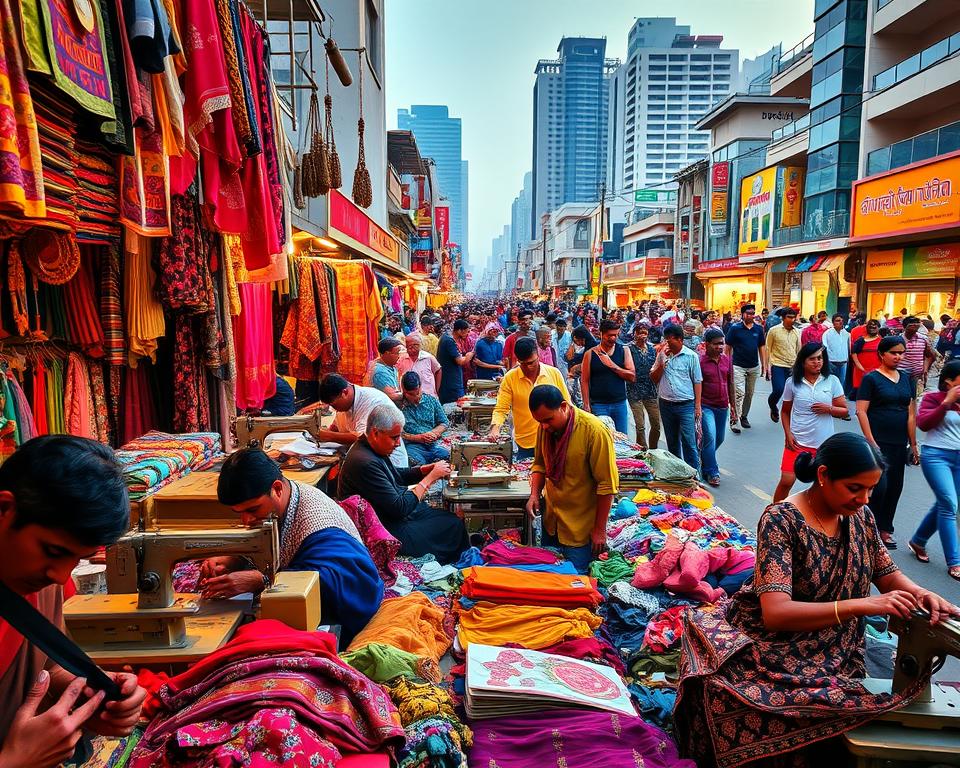The fashion industry in India is growing fast. This is because more people want skilled tailors and garment makers. Many new jobs are opening up in boutiques and factories.
The India fashion industry is full of life and variety. It needs people for many jobs in tailoring and making clothes. Whether it’s making custom clothes in boutiques or working on big production lines, there’s a lot to choose from.
Key Takeaways
- The India fashion industry is growing, driven by demand for skilled tailors.
- Boutique and factory openings are creating new job opportunities.
- Skilled professionals are needed for various roles in garment production.
- The industry offers a range of career paths for individuals.
- Opportunities exist for those with expertise in tailoring and garment production.
The Current State of India’s Tailoring Industry
India’s tailoring industry mixes old skills with new ways. It meets the needs of both local and global markets.
Market Size and Growth Projections
The garment making in India is big for the economy. It’s growing because more people want clothes at home and abroad.
Impact of Fashion Industry Expansion
The fashion world’s growth has changed tailoring jobs in India. Now, there are chances in small shops and big factories.

Traditional vs Modern Tailoring Sectors
In India, tailoring combines old skills with new methods.
Regional Craft Traditions
India’s regions have their own craft styles. These styles shape the tailoring skills needed.
Industrial Manufacturing Evolution
New tech and methods have changed tailoring jobs. This has brought new ways to make clothes.
| Aspect | Traditional Tailoring | Modern Tailoring |
|---|---|---|
| Techniques | Manual, labour-intensive | Mechanised, technology-driven |
| Output | Custom, bespoke clothing | Mass-produced garments |
| Skills Required | Advanced hand-sewing skills, knowledge of traditional fabrics | Proficiency in using industrial sewing machines, understanding of modern textile science |
Understanding Tailoring Jobs in India – Boutique & Factory Openings
Tailoring jobs in India cover many roles. You can work in luxury boutiques or garment factories. Each path has its own challenges and chances.
Boutique Tailoring Positions Explained
Boutique tailoring is about making high-end, custom clothes. You need to know about fashion trends. Also, you must work well with clients to make their designs real.
Custom Tailors and Fitters
Custom tailors and fitters make clothes that fit perfectly. They listen to what clients want. They take precise measurements for a great fit.
Alteration Specialists
Alteration specialists fix existing clothes to fit better. They adjust hems and seams. They make sure clothes fit just right.

Factory-Based Tailoring Roles
Factory tailoring is about making lots of clothes quickly. It’s fast-paced. Tailors must work fast to meet demand.
Production Line Tailors
Production line tailors work on parts of clothes like sleeves. They use big sewing machines. They work under tight deadlines.
Quality Control Positions
Quality control specialists check clothes for mistakes. They make sure clothes are up to standard. Their work keeps the brand’s good name.
Comparing Work Environments and Expectations
Boutique and factory tailoring are very different. Boutique tailors work in a calm place, focusing on clients. Factory tailors work fast, aiming for efficiency.
Essential Skills and Qualifications for Tailoring Professionals
Aspiring tailors in India must learn a lot to do well. They need skills for both small shops and big factories. Tailoring is about being good with your hands, creative, and able to talk well with people.
Technical Sewing and Pattern-Making Skills
Knowing how to sew and make patterns is key. Tailors must understand fabrics, learn sewing tricks, and make accurate patterns.
Design Knowledge and Aesthetic Sense
A tailor should also know about design and have taste. They need to keep up with fashion and pay attention to details to make clothes that look great.
Soft Skills for Client Interaction
Being good with people is very important. Tailors must talk well, listen to what clients want, and serve them well to keep customers coming back.
Formal Education vs Practical Experience
There’s a big debate about school vs real-world experience. School gives a base, but real experience is key to getting better. Many tailors do both to be the best.
| Skill Type | Description | Importance Level |
|---|---|---|
| Technical Sewing | Mastery of sewing techniques and equipment | High |
| Pattern-Making | Ability to create precise garment patterns | High |
| Design Knowledge | Understanding of current fashion trends | Medium |
| Soft Skills | Effective communication and customer service | High |
How to Build a Strong Tailoring Portfolio
A strong portfolio is like a visual resume for tailors. It shows off their skills and style. It’s key for tailors in India’s busy fashion world.
Documenting Your Best Work
Start by picking your best pieces. Make sure each one shows your skill and taste. Choose items that show you can work with different fabrics and designs.
Creating Sample Pieces
Make samples that show off your talents, like fancy embroidery or tricky patterns. These will prove your skills in a real way.
Digital Portfolio Development
Photography Tips for Garments
Use bright lights and top-notch cameras to show off your work. If you can, get a pro photographer.
Online Platforms for Showcasing Work
Use sites like Behance or your own website to share your work. Make sure your online look is as good as your physical one.
Finding Tailoring Job Openings in Boutiques
Finding the right tailoring job in a boutique takes online search, networking, and direct approaches. You need to be proactive and strategic in your job hunt.
Online Job Portals for Fashion Professionals
Online job portals are key for finding boutique tailoring jobs. Sites like LinkedIn, indeed, and fashion job boards list tailoring jobs. Make sure your resume and cover letter fit the job you’re applying for.
Networking in Fashion Circles
Networking in the fashion world can really help. Go to fashion events, join groups, and meet boutique owners and tailors. This builds a strong network for you.
Direct Approaches to Boutique Owners
Directly asking boutique owners about jobs can be very effective. Look for boutiques that match your style and skills. Then, ask about job openings. This shows you’re eager and proactive.
Social Media Strategies for Job Hunting
Social media like Instagram and Facebook can help find jobs. Follow boutiques you like, engage with their posts, and show off your work. This can connect you with employers.
Using these strategies can make you more visible and increase your job chances. Keep trying and be flexible in your job search. This is how you succeed.
Securing Factory Tailoring Positions
To get a job in factory tailoring, you need to know where the big garment factories are in India. The country’s garment industry is huge. It employs lots of tailors in many factories.
Major Garment Manufacturing Hubs in India
India has big places for making clothes, like Delhi-NCR, Mumbai, and Bangalore. These areas make lots of clothes for export. Delhi-NCR is famous for its many factories making all sorts of clothes.
Factory Recruitment Processes
Getting a job in a factory involves a few steps. You can look online, apply directly, or use a placement agency. Factories usually post jobs on their websites or local job sites.
Working with Placement Agencies
Placement agencies help find jobs in factories. They know a lot about the hiring process. They also help you get ready for interviews.
Understanding Factory Hiring Cycles
When factories hire can change with the seasons. They often hire more in busy times. Knowing this can help you apply at the right time.
Crafting an Effective Tailoring Resume and Cover Letter
When you apply for tailoring jobs, a good resume and cover letter are key. In India’s busy tailoring job market, you need to show off your skills and experience well.
Highlighting Relevant Skills and Experience
Your resume should show off your tailoring skills like pattern-making and sewing. Mention any fashion industry experience, like working in boutiques or factories.
Key skills to highlight:
- Technical sewing and pattern-making
- Design knowledge and aesthetic sense
- Soft skills for client interaction
Showcasing Specialisations and Techniques
If you’re good at special tailoring skills like embroidery or bespoke tailoring, show it off in your resume and cover letter.
Tailoring Your Application to the Position
Make sure your application fits the job you’re applying for. Understand what the job needs and show how you fit the bill.
Boutique-Focused Applications
For boutique jobs, talk about your client skills, bespoke tailoring, and working with delicate fabrics.
Factory-Oriented Resumes
For factory jobs, highlight your speed, ability to work on many pieces at once, and experience with big sewing machines.
| Application Aspect | Boutique Focus | Factory Focus |
|---|---|---|
| Key Skills | Client interaction, bespoke tailoring | Efficient production, industrial machinery |
| Experience | Bespoke tailoring, high-end fashion | Mass production, quality control |
Preparing for Tailoring Job Interviews
Getting ready for a tailoring job interview is more than just knowing your skills. It’s about showing them off well. Whether it’s for a boutique or a factory, knowing the interview process well can really help you.
Common Interview Questions
Interviews for tailoring jobs have both general and technical questions. You might talk about working with different fabrics, sewing techniques, and handling complex designs. They might also ask about working under pressure and meeting deadlines.
Practical Skills Demonstrations
Many interviews include showing off your practical skills. This could be altering clothes, making simple accessories, or using specific machines.
Hand Sewing Tests
Some interviews might test your hand sewing skills. Make sure you can do basic stitches like the running stitch and backstitch.
Machine Operation Assessments
If you’re applying for a factory job, you might need to show you can use industrial sewing machines. Get to know different machines and practice using them well.
| Skill Demonstrated | Relevance to Boutique | Relevance to Factory |
|---|---|---|
| Hand Sewing | High | Moderate |
| Machine Operation | Moderate | High |
| Fabric Knowledge | High | High |
What to Bring to Your Interview
It’s a good idea to bring a portfolio of your work. Include photos of clothes you’ve made or altered. Also, bring any certificates or references that show your skills.
Following Up After Interviews
After the interview, send a thank-you email. Say thank you for their time and show you’re really interested in the job. It shows you’re professional and keeps you in their mind.
Salary Expectations and Negotiation Tips
Knowing what you can earn is key for tailoring jobs in India. Salaries vary a lot. This depends on the job type, where you work, and how much experience you have.
Salary Ranges Across Different Positions
Salaries differ in the tailoring world. A boutique tailor with special skills gets paid more than a factory worker. Experienced tailors can make ₹15,000 to ₹30,000 a month. This depends on their skills and the prestige of their workplace.
Regional Salary Variations
Where you live also affects your pay. Big cities like Mumbai and Delhi pay more. For example, a tailor in Mumbai might earn 20% more than one in a smaller town.
Negotiating Better Compensation
Good negotiation skills help you get a better deal. Tailors should know the market rates, show off their skills, and explain why they’re valuable. Being well-prepared is essential for negotiation success.
Benefits Beyond Basic Salary
Many tailoring jobs offer more than just a salary. You might get health insurance, paid holidays, and bonuses. Knowing all the benefits helps tailors make better career choices.
Regional Hotspots for Tailoring Jobs in India
India’s tailoring scene is buzzing in places like Delhi and Mumbai. These cities are changing the way we see tailoring. They offer many chances for tailoring pros across the country.
Delhi-NCR Fashion Industry
The Delhi-NCR area is a big deal for fashion. It has lots of boutiques, fashion houses, and factories. Tailors can find work in fancy boutiques or big factories here.
Mumbai’s Boutique Scene
Mumbai is famous for its boutiques. It’s where high-end designers and luxury shops are. Tailors who know bespoke and high-fashion can do well here.
Chennai and Bangalore Opportunities
Chennai and Bangalore are growing in the tailoring world. Chennai has traditional clothes, while Bangalore is modern. Both offer unique chances for tailors.
Emerging Markets in Tier-2 Cities
Cities like Jaipur and Surat are getting bigger in textiles and garments. They have jobs for tailors, from old-fashioned clothes to new textile stuff.
Jaipur’s Traditional Garment Industry
Jaipur is all about traditional clothes and embroidery. Tailors who know these old ways can find work here.
Surat’s Textile Manufacturing
Surat is a big name in textiles. It makes clothes for India and the world. Tailors and garment workers can find jobs in Surat’s textile places.
| City | Industry Focus | Opportunities for Tailors |
|---|---|---|
| Delhi-NCR | Fashion, Garment Manufacturing | High-end boutiques, garment factories |
| Mumbai | Luxury Fashion, Bespoke Tailoring | High-end fashion designers, luxury boutiques |
| Chennai | Traditional Garments, Modern Fashion | Traditional garment industry, modern fashion scene |
| Bangalore | Modern Fashion, Tech-Enabled Garment Production | Modern fashion designers, tech-enabled garment production units |
| Jaipur | Traditional Garments, Embroidery | Traditional garment industry, embroidery and craftsmanship |
| Surat | Textile Manufacturing, Garment Production | Textile mills, garment manufacturing units |
Advancing Your Tailoring Career
To grow in the tailoring field in India, you need a plan. There are many ways to move up, from working in shops to running factory lines.
From Assistant to Master Tailor
Getting from assistant to master tailor takes skill and knowledge. Key skills include pattern-making, fabric selection, and garment construction. With time, you can handle bigger tasks and lead teams or start your own shop.
Specialisation Opportunities
Choosing a special area in tailoring can boost your career. Two big areas are:
- Bridal Wear Expertise: Making custom bridal wear needs precision and creativity.
- Menswear Tailoring: Understanding men’s fashion, like bespoke suits, is key.
Bridal Wear Expertise
Bridal wear experts must work with delicate fabrics and meet client needs.
Menswear Tailoring
Menswear tailors must keep up with men’s fashion trends, including styles and fabrics.
Moving Between Boutiques and Factories
Many start in boutiques, learning about clients and bespoke tailoring. Then, they move to factories for new challenges and growth.
Leadership Roles in Tailoring
Seasoned tailors can lead teams, manage production, and check quality. Good leaders in tailoring have strong communication, attention to detail, and team motivation.
Training and Education Pathways
Aspiring tailors in India have many training paths to choose from. Each path offers unique benefits and specialisations. This means everyone can find a way to grow their skills.
Formal Fashion Design Courses
Many institutions in India offer formal fashion design courses. These courses teach design, pattern making, and garment construction. They often give recognised certifications, making it easier to find a job.
Specialised Tailoring Programmes
Specialised programmes focus on areas like haute couture, bridal wear, or menswear. They’re perfect for those who want to be experts in a specific field.
Apprenticeships and On-the-Job Training
Apprenticeships and on-the-job training give you real-world experience. You learn from experts. This hands-on training is key to mastering the trade.
Online Learning Resources
Online resources, like video tutorials and courses, offer flexibility. They’re great for those who can’t go to classes. You can also get industry certifications online, proving your skills.
Video Tutorials and Courses
Video tutorials and online courses teach a wide range of skills. They cover everything from basic sewing to advanced techniques. These platforms are very popular with aspiring tailors.
Industry Certifications
Getting industry certifications from well-known fashion institutions boosts your career. It makes you more credible and attractive to employers.
| Training Pathway | Key Benefits |
|---|---|
| Formal Fashion Design Courses | Comprehensive training, recognised certifications |
| Specialised Tailoring Programmes | Niche expertise, enhanced employability |
| Apprenticeships and On-the-Job Training | Practical experience, industry insights |
| Online Learning Resources | Flexibility, accessibility |
Overcoming Challenges in the Tailoring Job Market
The Indian tailoring sector faces many job market challenges. These issues can affect how long tailors work and how happy they are in their jobs.
Handling Seasonal Employment
Seasonal employment is a big challenge. Demand changes with festivals or special events. Tailors can learn new skills or offer custom services to stay busy.
Managing Tight Deadlines
Dealing with tight deadlines is tough. Good time management and task prioritisation help meet client needs without losing quality.
Adapting to Changing Fashion Trends
Being able to adapt to changing fashion trends is key. Learning new styles and techniques keeps tailors up-to-date and relevant.
Work-Life Balance in High-Pressure Environments
Keeping a work-life balance in stressful jobs is important. Setting boundaries and taking breaks helps manage stress.
By tackling these challenges, tailoring professionals in India can improve their job chances. They can build a lasting career in the industry.
Success Stories: From Tailor to Fashion Entrepreneur
To become a fashion entrepreneur from a tailor, you need dedication, creativity, and business skills. Many tailors have turned their talents into thriving businesses.
Profiles of Successful Tailors
Rahul Mehta, a tailor from Mumbai, made his boutique famous. He did this by focusing on details and understanding what his clients want.
Lessons from Their Career Journeys
The success of these tailors teaches us important lessons. They show us the value of quality craftsmanship, understanding market trends, and effective client communication.
Starting Your Own Tailoring Business
Starting a tailoring business involves several steps. You need to make a business plan, create a brand, and find clients.
Boutique Establishment Guidelines
Setting up a boutique needs careful planning. You must pick a good location, design an attractive store, and offer unique products.
Building a Client Base
Having a loyal client base is key for success. This comes from excellent customer service, quality products, and effective marketing strategies.
By following these tips and learning from successful tailors, you can succeed in the fashion world.
Future Trends in India’s Tailoring Industry
Technology and sustainability are changing India’s tailoring world. New trends are making the industry grow and change.
Technology Integration in Tailoring
Technology is making tailoring better. New machines and software help make clothes faster and more accurately.
Digital Pattern Making
Digital pattern making is getting popular. It lets tailors design clothes more easily and quickly. This also helps save resources and work better.
Automated Cutting Systems
Automated cutting systems are a big step forward. They cut fabric accurately without much help from people. This makes making clothes faster and less likely to have mistakes.
Sustainable and Ethical Fashion Impact
Sustainability is key in tailoring now. People want clothes that are good for the planet. Tailors are using green materials and cutting down on waste.
There’s a big push for green fashion. It’s because people want to help the planet. Tailors are using eco-friendly stuff and recycling to help.
Emerging Job Roles and Opportunities
The tailoring world in India is growing. New jobs are coming up that need special skills.
New jobs include digital pattern makers and green fashion experts. These roles will help the industry grow and get better.
Conclusion
The tailoring industry in India is growing fast. This is because more people want custom clothes. There are jobs in boutiques and factories, each with its own needs and challenges.
To do well in tailoring, you need skills, creativity, and good people skills. It’s important to have a strong portfolio and a good resume. Also, being ready for interviews is key to getting a job in the fashion world of India.
Getting advice on your career is very important. Knowing the market, trends, and training options helps you make smart choices. This way, you can plan your career path well.
The industry is changing, and we must keep up with new tech, green practices, and roles. With hard work and the right advice, you can have a great career in India’s fashion world.


